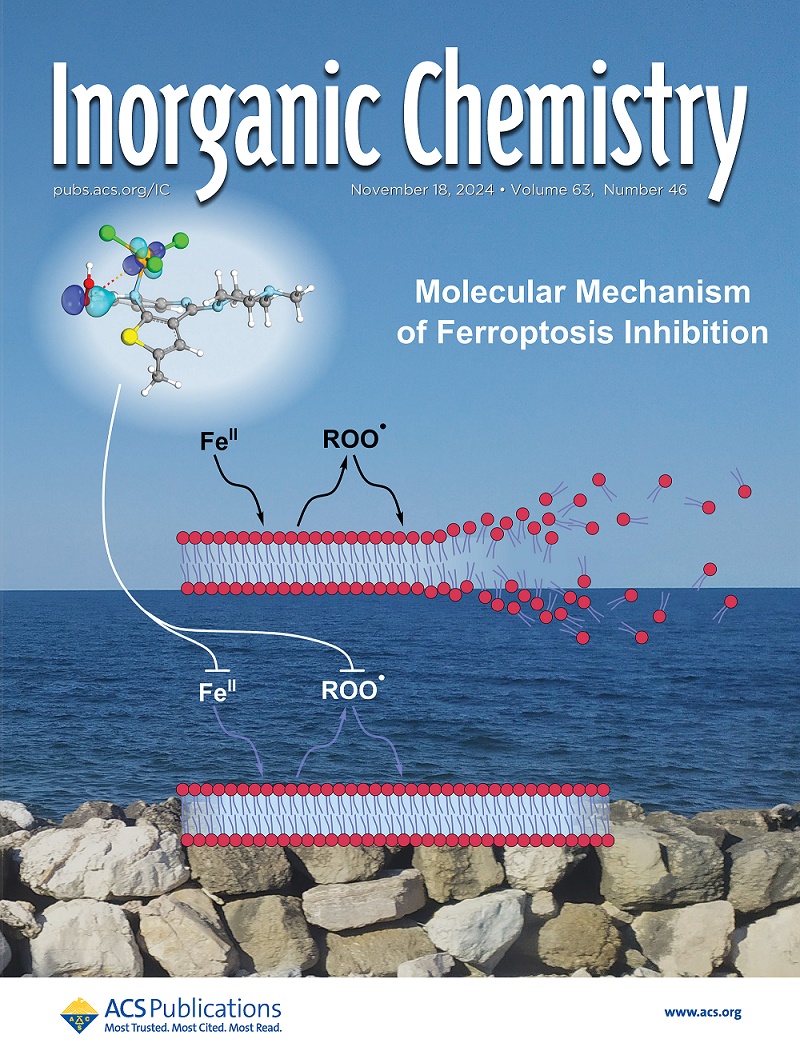一维金链结构晶体中[Au(CN)2]-低聚物的发射特性
IF 4.7
2区 化学
Q1 CHEMISTRY, INORGANIC & NUCLEAR
引用次数: 0
摘要
发现(Me4N)3[Au(CN)2]2Cl (Me4N:四甲基铵,1)和Et4N[Au(CN)2] (Et4N:四乙基铵,2)的晶体结构包含一维Au链结构,其中Au··Au距离在1和2中分别为3.3 Å和3.6 Å。由于基态低聚物的结构具有线性交错结构,因此在这些晶体中产生的光激发低聚物也有望具有线性交错结构。晶体在77 K下表现出发射特性,主要发射波段为1中的430 nm和2中的400 nm,发射量子产率一致。这些在77 K下的发射带可归属于线性交错结构的四聚体和三聚体的磷光,因为它们类似于水溶液中的三聚体和四聚体的磷光。根据量子产率和寿命估计,T1三聚体和T1四聚体的辐射寿命分别为0.9和1.6 μs。在4 ~ 110 K的温度范围内观察了2的发射寿命,估计了三聚体最低三重态的零场分裂分别为36 cm-1 (EI-II)和64 cm-1 (EI-III),三态的辐射速率常数分别为1.43 × 103 s-1 (kI)、2.0 × 104 s-1 (kII)和4.8 × 106 s-1 (kIII)。本文章由计算机程序翻译,如有差异,请以英文原文为准。
Emission Properties of [Au(CN)2]- Oligomers in Crystals with One-Dimensional Au Chain Structures.
The crystal structures of (Me4N)3[Au(CN)2]2Cl (Me4N: tetra-methylammonium, 1) and Et4N[Au(CN)2] (Et4N: tetra-ethylammonium, 2) were found to include 1-dimensional Au chain structures, where the Au···Au distance is as short as 3.3 Å in 1 and 3.6 Å in 2. Because the structures of the ground state oligomers have linear staggered structures, the photoexcited oligomers generated in these crystals are also expected to have linear staggered structures. The crystals exhibit emission, in which the dominant emission bands are located at 430 nm in 1 and 400 nm in 2 at 77 K with emission quantum yields of unity. These emission bands at 77 K were assignable to the phosphorescence of the tetramer and trimer of linear-staggered structures because they resemble the phosphorescence of the trimer and tetramer in aqueous solutions. The radiative lifetimes of the T1 trimer and T1 tetramer were estimated as 0.9 and 1.6 μs, respectively, from their quantum yields and lifetimes. The emission lifetime of 2 was observed in the temperature region of 4-110 K to estimate the zero-field splitting of the lowest triplet state of the trimer as 36 cm-1 (EI-II) and 64 cm-1 (EI-III) and the radiative rate constants of the three states as 1.43 × 103 s-1 (kI), 2.0 × 104 s-1 (kII), 4.8 × 106 s-1 (kIII).
求助全文
通过发布文献求助,成功后即可免费获取论文全文。
去求助
来源期刊

Inorganic Chemistry
化学-无机化学与核化学
CiteScore
7.60
自引率
13.00%
发文量
1960
审稿时长
1.9 months
期刊介绍:
Inorganic Chemistry publishes fundamental studies in all phases of inorganic chemistry. Coverage includes experimental and theoretical reports on quantitative studies of structure and thermodynamics, kinetics, mechanisms of inorganic reactions, bioinorganic chemistry, and relevant aspects of organometallic chemistry, solid-state phenomena, and chemical bonding theory. Emphasis is placed on the synthesis, structure, thermodynamics, reactivity, spectroscopy, and bonding properties of significant new and known compounds.
 求助内容:
求助内容: 应助结果提醒方式:
应助结果提醒方式:


